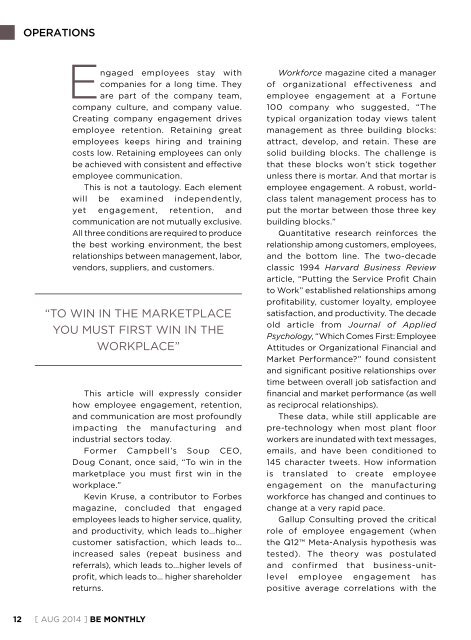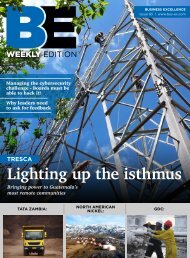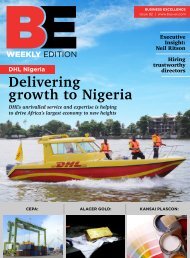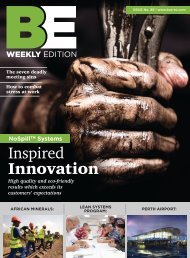Nickel in demand
You also want an ePaper? Increase the reach of your titles
YUMPU automatically turns print PDFs into web optimized ePapers that Google loves.
operations<br />
Engaged employees stay with<br />
companies for a long time. They<br />
are part of the company team,<br />
company culture, and company value.<br />
Creat<strong>in</strong>g company engagement drives<br />
employee retention. Reta<strong>in</strong><strong>in</strong>g great<br />
employees keeps hir<strong>in</strong>g and tra<strong>in</strong><strong>in</strong>g<br />
costs low. Reta<strong>in</strong><strong>in</strong>g employees can only<br />
be achieved with consistent and effective<br />
employee communication.<br />
This is not a tautology. Each element<br />
will be exam<strong>in</strong>ed <strong>in</strong>dependently,<br />
yet engagement, retention, and<br />
communication are not mutually exclusive.<br />
All three conditions are required to produce<br />
the best work<strong>in</strong>g environment, the best<br />
relationships between management, labor,<br />
vendors, suppliers, and customers.<br />
“To w<strong>in</strong> <strong>in</strong> the marketplace<br />
you must first w<strong>in</strong> <strong>in</strong> the<br />
workplace”<br />
This article will expressly consider<br />
how employee engagement, retention,<br />
and communication are most profoundly<br />
impact<strong>in</strong>g the manufactur<strong>in</strong>g and<br />
<strong>in</strong>dustrial sectors today.<br />
Former Campbell’s Soup CEO,<br />
Doug Conant, once said, “To w<strong>in</strong> <strong>in</strong> the<br />
marketplace you must first w<strong>in</strong> <strong>in</strong> the<br />
workplace.”<br />
Kev<strong>in</strong> Kruse, a contributor to Forbes<br />
magaz<strong>in</strong>e, concluded that engaged<br />
employees leads to higher service, quality,<br />
and productivity, which leads to…higher<br />
customer satisfaction, which leads to…<br />
<strong>in</strong>creased sales (repeat bus<strong>in</strong>ess and<br />
referrals), which leads to…higher levels of<br />
profit, which leads to… higher shareholder<br />
returns.<br />
Workforce magaz<strong>in</strong>e cited a manager<br />
of organizational effectiveness and<br />
employee engagement at a Fortune<br />
100 company who suggested, “The<br />
typical organization today views talent<br />
management as three build<strong>in</strong>g blocks:<br />
attract, develop, and reta<strong>in</strong>. These are<br />
solid build<strong>in</strong>g blocks. The challenge is<br />
that these blocks won’t stick together<br />
unless there is mortar. And that mortar is<br />
employee engagement. A robust, worldclass<br />
talent management process has to<br />
put the mortar between those three key<br />
build<strong>in</strong>g blocks.”<br />
Quantitative research re<strong>in</strong>forces the<br />
relationship among customers, employees,<br />
and the bottom l<strong>in</strong>e. The two-decade<br />
classic 1994 Harvard Bus<strong>in</strong>ess Review<br />
article, “Putt<strong>in</strong>g the Service Profit Cha<strong>in</strong><br />
to Work” established relationships among<br />
profitability, customer loyalty, employee<br />
satisfaction, and productivity. The decade<br />
old article from Journal of Applied<br />
Psychology, “Which Comes First: Employee<br />
Attitudes or Organizational F<strong>in</strong>ancial and<br />
Market Performance?” found consistent<br />
and significant positive relationships over<br />
time between overall job satisfaction and<br />
f<strong>in</strong>ancial and market performance (as well<br />
as reciprocal relationships).<br />
These data, while still applicable are<br />
pre-technology when most plant floor<br />
workers are <strong>in</strong>undated with text messages,<br />
emails, and have been conditioned to<br />
145 character tweets. How <strong>in</strong>formation<br />
is translated to create employee<br />
engagement on the manufactur<strong>in</strong>g<br />
workforce has changed and cont<strong>in</strong>ues to<br />
change at a very rapid pace.<br />
Gallup Consult<strong>in</strong>g proved the critical<br />
role of employee engagement (when<br />
the Q12 Meta-Analysis hypothesis was<br />
tested). The theory was postulated<br />
and confirmed that bus<strong>in</strong>ess-unitlevel<br />
employee engagement has<br />
positive average correlations with the<br />
12<br />
[ Aug 2014 ] BE Monthly





